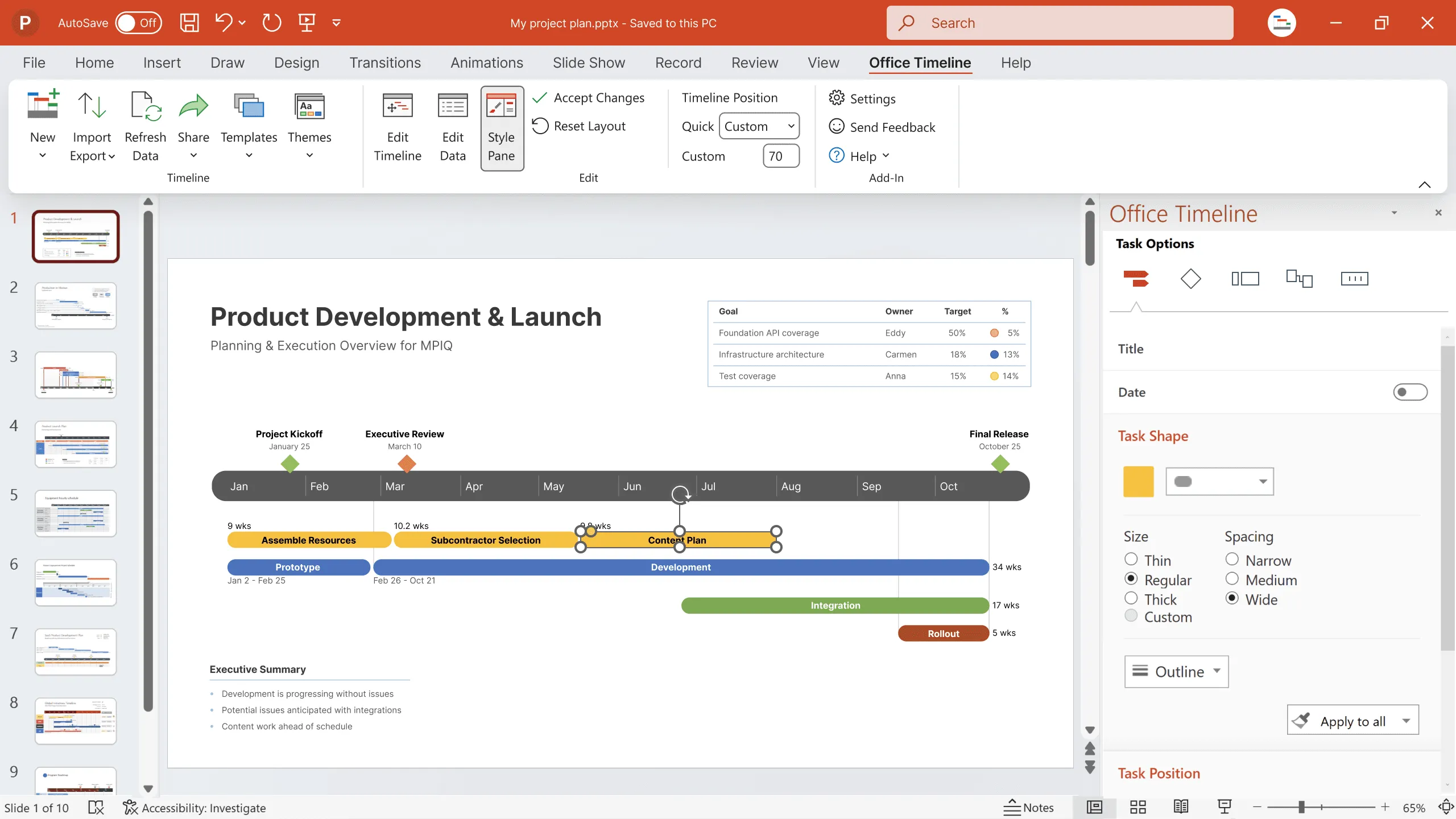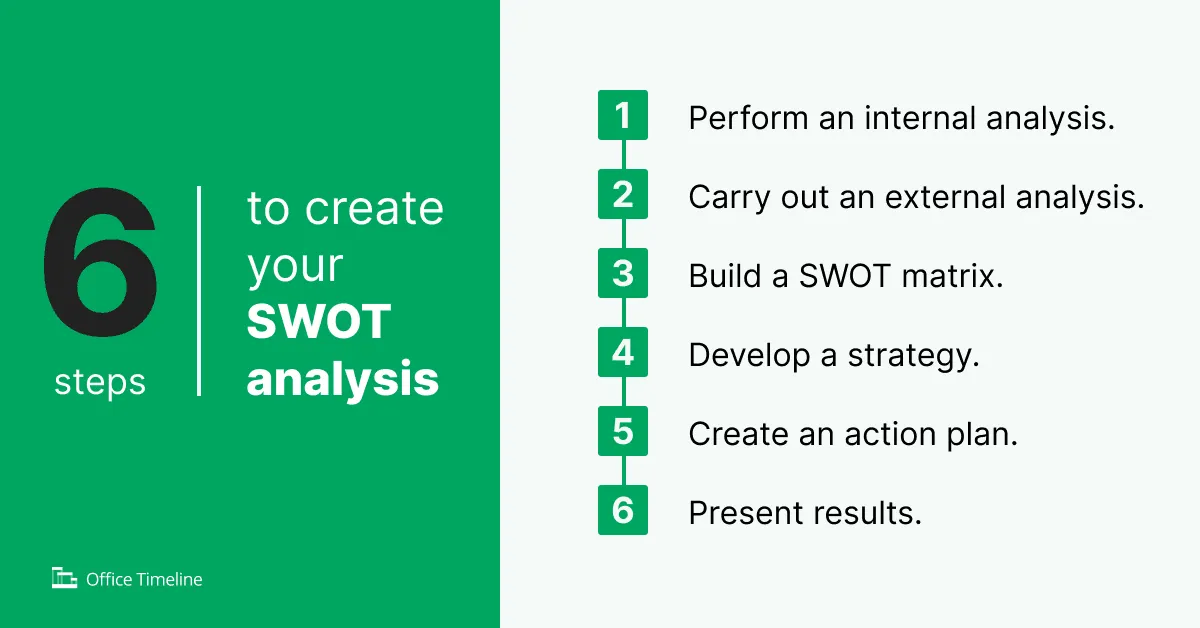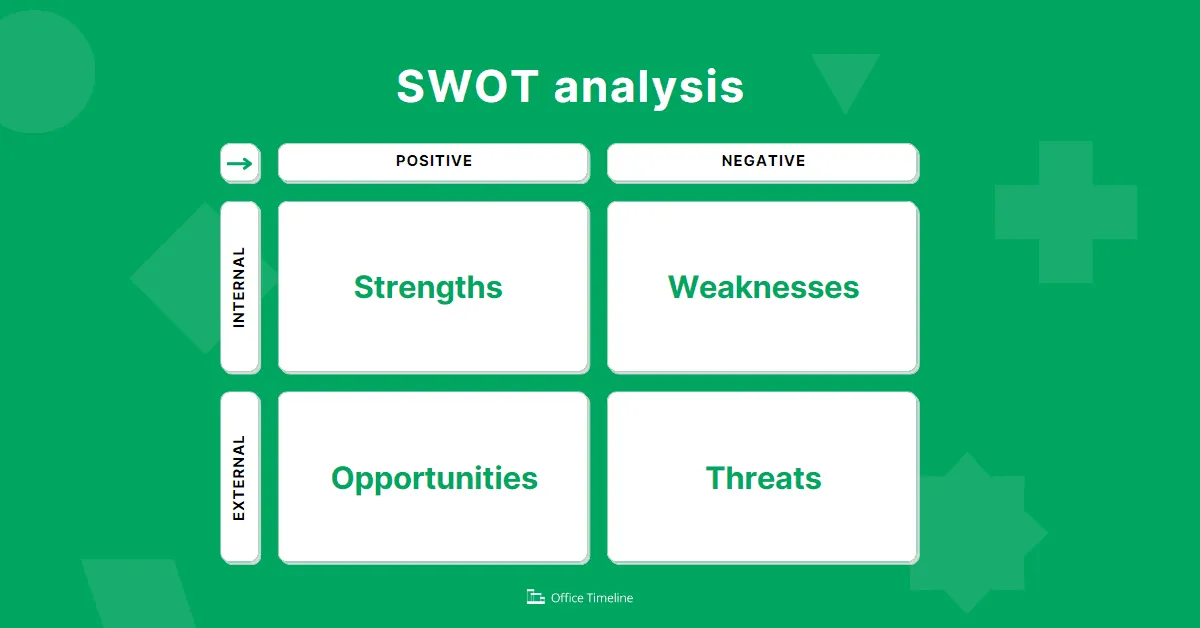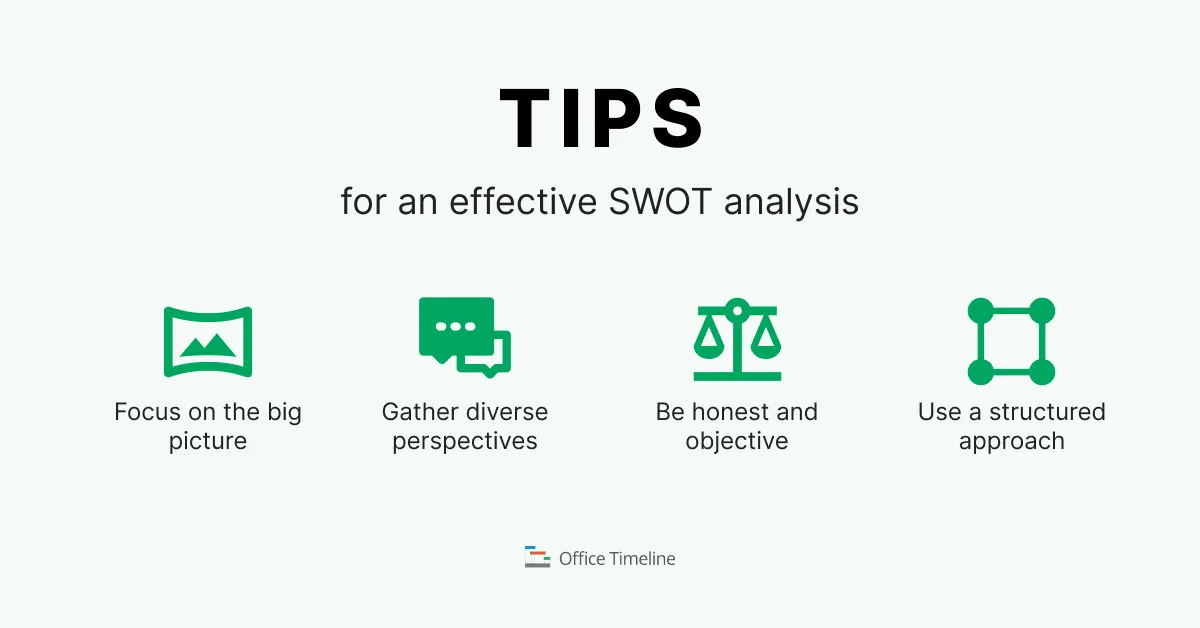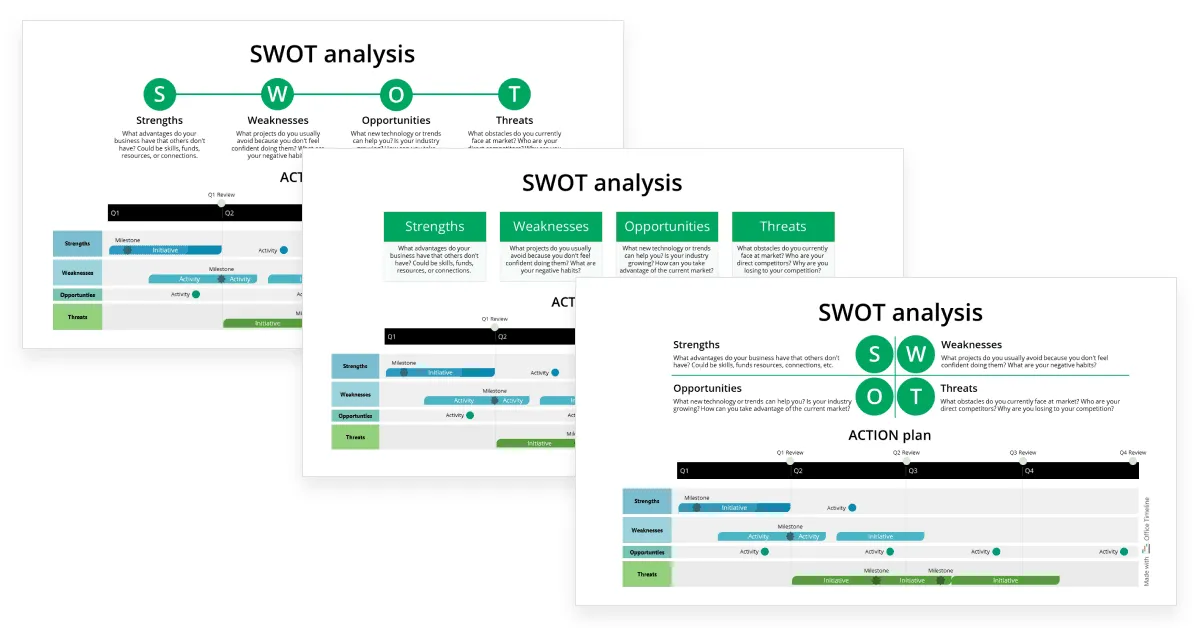SWOT analysis: how to plan for success
Learn how to use SWOT analysis for growth in today’s business environment. Free downloadable SWOT template included.
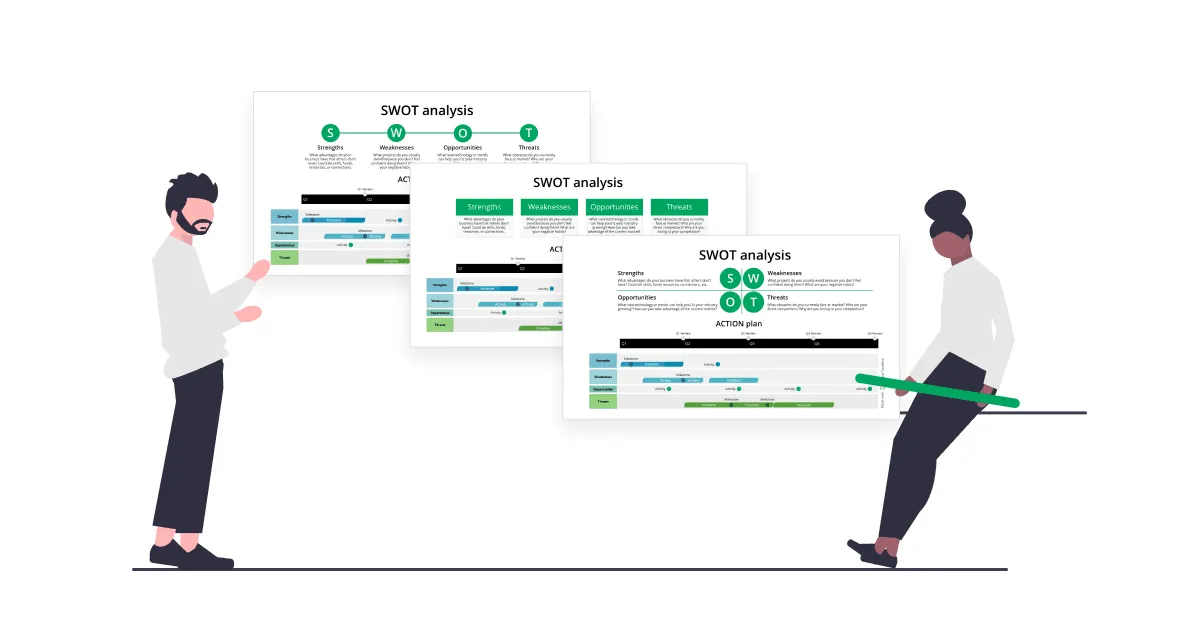
In today’s rapidly changing business landscape, it is more important than ever for businesses to step up their strategic planning. One of the most widely used tools in the planning toolkit is the SWOT analysis. This technique relies on analyzing the internal and external environments of a business, aiming to gain actionable insights. Based on these findings, businesses develop strategies to capitalize on strengths, address weaknesses, take advantage of opportunities, and minimize threats.
In this article, we will take a closer look at the role of SWOT analysis in strategic planning, we’ll find some key steps for conducting a SWOT analysis and we’ll look at how to use the results to inform strategic decision-making. We will also provide some practical tips and free templates for a head start with your SWOT analysis.
1. What is SWOT? A definition of the SWOT analysis
SWOT stands for Strengths, Weaknesses, Opportunities and Threats. The SWOT analysis is a strategic planning tool used by businesses to assess the internal and external factors that affect them. This includes identifying and evaluating internal strengths and weaknesses, as well as external opportunities and threats.
Let’s see what each of these categories represents:
- Strengths – the areas where the organization excels or has a competitive advantage over others.
- Weaknesses – the areas that put the company at a disadvantage. These are the areas where the organization needs to improve or faces challenges that may affect its performance.
- Opportunities – external factors that the organization can take advantage of to grow.
- Threats – external factors that may constitute a risk or challenge.
A SWOT analysis provides a structured way to identify the key factors that can impact a business or project’s success. Its role is to help organizations develop strategies that use their strengths and opportunities to their advantage while reducing their weaknesses and threats.
SWOT analysis can be applied to various scenarios, such as new product development, marketing, and business expansion. Despite the emergence of newer and more complex strategic analysis tools, SWOT analysis remains popular due to its simplicity, flexibility, and ability to provide a clear overview of a business or project’s current state.
However, it’s important to note that SWOT analysis is just one tool in a broader strategic planning toolkit. To ensure a comprehensive approach, it should be used in combination with other strategic analysis tools and frameworks.
1.1 A brief history of SWOT
While long used in business strategic planning, SWOT analysis still has unclear origins. It is said to have come into existence at about the same time as the concepts of business strategy and corporate planning (1960s). Still, some sources say that SWOT was developed in the early 1950s at Harvard Business School to analyze organizational strategies in relation to their environment.
Scholars later attributed the origins of SWOT in the 1960s to Albert Humphrey at Stanford Research Institute, who analyzed Fortune 500 companies, with the aim of creating a new system of change management and control. Albert Humphrey and his research team developed the Team Action Model (TAM) in the 1960s and 1970s.
They used a tool called SOFT (Satisfactory, Opportunity, Fault, Threat) analysis to explore key areas. As Albert Humphrey described it: “What is good in the present is Satisfactory, good in the future is an Opportunity; bad in the present is a Fault, and bad in the future is a Threat”.
The four components of SWOT appeared in other publications on strategic planning by various authors by the end of the 1960s. The acronym SWOT appeared in the title of a journal article in 1972, and a 2×2 SWOT matrix is found in a 1980 article by Professor Igor Ansoff. However, he used the acronym TOSW instead of SWOT.
2. How to identify and analyze each of the four SWOT elements
The first step in understanding and assessing the current state of a business or project is identifying the four SWOT elements (Strengths, Weaknesses, Opportunities, and Threats) related to that business. This process involves gathering data from relevant data sources, such as financial reports and customer feedback, and analyzing the internal and external factors.
To guide this process, a good practice is to start by asking the right questions. To answer them, you can employ techniques such as conducting market research, SWOT analysis workshops, or stakeholder interviews.
Here are some suggestions and examples for each of the SWOT elements that might help you define your own SWOT analysis framework (that can also be applied to analyze competition).
2.1 Strengths in SWOT analysis
Definition:
Strengths are internal factors that give an entity an advantage over others.
Examples:
- Strong brand reputation and a loyal customer base of a company.
- An individual has excellent communication skills and a strong work ethic.
Questions to ask:
- What do we do well?
- What are our unique selling points?
- What are our core competencies?
- What resources do we have at our disposal (e.g., financial, technological, human)?
- What advantages do we have over competitors?
- Where are we making the most money?
- What positive feedback do we receive from customers, clients, or stakeholders?
2.2 Weaknesses in SWOT analysis
Definition:
Weaknesses are internal factors that limit a company’s ability to achieve its objectives. It puts the company at a disadvantage and can hinder its capacity to compete effectively in the marketplace.
Examples:
- Lack of brand recognition or reputation
- Limited financial resources or access to funding
- Lack of skills or expertise
- Poor product quality or design
- Inefficient production processes
- High employee turnover or low employee morale
- Inadequate technology or outdated systems
Questions to ask:
- What are we doing poorly?
- What areas of our business are we struggling to improve or grow?
- Where are we losing money?
- What resources do we lack compared to our competitors?
- What internal processes are inefficient or hindering our productivity?
- Are we lacking in any key skills or expertise needed to compete in our industry?
- What negative feedback have we received from customers or employees?
- Are we operating with outdated technology or systems that need upgrading?
2.3 Opportunities in SWOT analysis
Definition:
Opportunities are external factors that a company can leverage to its advantage and achieve its objectives or gain a competitive advantage. They can include trends in the market, changes in customer behavior, emerging technologies, or any other factor that presents a chance for growth or improvement.
Examples:
- Increasing demand for products or services
- Emerging technologies that can improve product design or production processes
- Expanding global markets
- Increased international trade opportunities
- Changes in government regulations that benefit the industry
Questions to ask:
- What market trends are emerging that could benefit our business?
- What are some niches that our competitors are missing?
- What new technologies are being developed that could improve our products or services?
- Are there new needs or any changes in customer behavior or preferences that we can capitalize on?
- Are there any regulatory or legal changes that could benefit our industry?
- Are there any untapped or underserved markets that we could target?
- Are there any strategic partnerships or collaborations that could benefit our business?
2.4 Threats in SWOT analysis
Definition:
Threats are external factors that may pose a risk, may represent an obstacle or a challenge to a company’s success or competitiveness.
Examples:
- Increasing competition in the market
- Economic downturns or recessions
- Changes in consumer preferences or trends
- New technologies that can disrupt the industry
- Political instability or changes in government policies
- Natural disasters or other unexpected events
Questions to ask:
- What are the obstacles we need to overcome?
- What are our vulnerabilities?
- What new competitors are entering the market, and how do they compare to us?
- Are our competitors successful?
- Do we have any aggressive competitors?
- Are there any economic trends or market changes that could negatively impact our business?
- Are there any emerging technologies that could disrupt our industry or make our products or services obsolete?
- Are there any political or regulatory changes that could negatively impact our business?
- Are there any natural disasters or other unexpected events that could disrupt our operations?
- What negative feedback have we received from customers or employees, and how could it impact our business?
3. How to conduct a SWOT analysis
To perform a SWOT analysis, you should first take into consideration the following key ideas:
- A SWOT analysis starts by identifying the internal strengths and weaknesses of an organization. Included here are its unique value proposition, core competencies, but also operational inefficiencies.
- It continues by identifying the external opportunities and threats that can impact the business, such as emerging trends, changing market conditions, or possible competitive pressures.
- Then, an objective analysis and evaluation is needed. An important step of a SWOT analysis is considering the impact of each factor on the business or project and prioritizing the most critical areas for improvement.
- And finally, all the insights should be used to develop a plan of action to address areas of weakness and capitalize on opportunities.
Among the potential limitations of the analysis are the limited availability of data, possibly biased interpretations, or setting an extremely narrow or broad scope of the analysis, which would lead to an incomplete or overwhelming assessment.
3.1 How do you do a SWOT analysis step-by-step?
A SWOT analysis can quickly identify opportunities and areas that require attention for your company. Using a step-by-step approach may be easier to follow and can ensure a thorough and accurate analysis.
Now that we’ve seen how to approach and analyze each SWOT element, we can put together a step-by-step process for how to do the analysis:
1. Perform an internal analysis.
The organization reviews its internal resources, capabilities, and performance. This can be done by analyzing financial statements, conducting employee surveys, reviewing procedures. The goal of the internal analysis is to identify the organization’s strengths and weaknesses.
2. Carry out an external analysis.
The organization reviews the external environment, including industry trends, competitor analysis, and market changes. This can be done by gathering data from market research, conducting surveys, and analyzing industry reports. The goal of the external analysis is to identify opportunities and threats in the external environment.
3. Build a SWOT matrix.
A visual SWOT matrix can easily show users the relationships between the internal and external factors affecting a business. The SWOT matrix consists of four individual squares that form one larger square, representing strengths, weaknesses, opportunities, and threats. See below more on the SWOT matrix and its variations.
4. Develop a strategy.
Based on the prioritized issues, develop a strategy that leverages the organization’s strengths to capitalize on opportunities and reduce the potential threats, and address the weaknesses that hinder its success. Set some goals.
5. Create an action plan.
As part of the strategy and based on the insights gained from the analysis, create an action plan to address issues or threats and leverage opportunities and strengths. For this, identify specific action points and prioritize them based on their potential impact and feasibility. Finally, the action points should be put on a timeline with milestones and deadlines to ensure timely execution and help monitoring progress towards achieving the goals.
6. Present results.
An effective way to present the steps and results of your SWOT analysis is to include all on a single slide. This can be easily done with the help of the Office Timeline add-in for PowerPoint and the free downloadable templates included on this page. You can summarize the entire SWOT analysis process, using graphs and charts to make the information visually appealing and easy to understand. And you can make tweaks and customizations to match the presentation to the organization’s branding and style, using custom colors and themes and adding logos.
3.2 What is a SWOT matrix?
The results of the SWOT analysis are often presented in the form of a matrix. A SWOT matrix, also known as a SWOT analysis grid, is a tool used to visually organize the results of a SWOT analysis.
A common way to display a SWOT analysis is a four-quadrant table with each quadrant representing one of the four elements of a SWOT analysis: strengths, weaknesses, opportunities, and threats. Within each category, information is listed to provide an inventory of relevant factors.
The SWOT matrix allows users to visualize the relationships between the internal and external factors that have an impact on a business. It can make it easier to identify potential strategic actions based on these factors.
3.3 Variations of the SWOT matrix
There are several variations of the SWOT matrix. Each variation has its own unique approach to organizing and analyzing information, allowing organizations to gain a more nuanced understanding of their situation.
The TOWS matrix
The TOWS (Threats, Opportunities, Weaknesses, Strengths) matrix builds on the SWOT matrix by suggesting specific strategies based on the interactions between the four elements. It is a tool for situational analysis that was developed by Heinz Weihrich. The TOWS matrix takes the SWOT analysis further by identifying how to use the SWOT factors to develop specific strategies.
It involves identifying the strengths, weaknesses, opportunities, and threats, and then creating specific actions based on these factors. For example, a strength can be used to capitalize on an opportunity, or a weakness can be addressed to minimize a threat.
Here are the four categories of factors combinations:
- Strengths and Opportunities (SO) – The SO strategies focus on how the organization can use its strengths to take advantage of the opportunities in the external environment.
- Strengths and Threats (ST) – ST strategies focus on how the organization can use its strengths to overcome the threats in the external environment.
- Weaknesses and Opportunities (WO) – WO strategies focus on how the organization can overcome its weaknesses to take advantage of the opportunities in the external environment.
- Weaknesses and Threats (WT) – WT strategies focus on how the organization can overcome its weaknesses and reduce the threats in the external environment.
The SOAR framework
The SOAR framework is a newer variation that focuses more on strengths and opportunities and aims to identify “strengths, opportunities, aspirations, and results” to guide strategic planning.
“SOAR is a strategic planning framework with an approach that focuses on strengths and seeks to understand the whole system by including the voices of the relevant stakeholders. SOAR conversations center on what an organization is doing right, what skills should be enhanced, and what is compelling to those who have a ‘stake’ in the organization’s success.” (Stavros, J. & Hinrichs, G. 2009. The thin book of SOAR: Building strengths-based strategy – as cited by the Libraries of University of Missouri).
The SVOR framework
SVOR is the SWOT of project management. It looks at Strengths, Vulnerabilities, Opportunities, and Risks from the point of view of the mathematical links between them. Also, SVOR compares project elements along two axes: internal and external, and positive and negative.
3.4 Limitations of the SWOT analysis
To avoid biased or incomplete analyses, take into account that any SWOT analysis can have its limitations. For example, you should prevent:
- Lack of context. SWOT analysis does not consider the organization’s history, culture, values, or stakeholder relationships, which can provide valuable context for the analysis.
- Lack of objectivity. SWOT analysis can be biased if the people conducting it have vested interests or preconceived notions about the organization, its industry, or the market. This can lead to overlooking key factors or overemphasizing certain aspects, which can result in flawed analysis.
- Narrow focus. Focusing on a narrow set of factors, SWOT analysis may exclude important considerations that could affect the organization’s performance. For example, it may not capture broader societal, economic, or environmental factors.
- Overreliance on templates or using inadequate templates. While templates can provide a useful starting point, they may not fully capture the unique characteristics and nuances of a business. Relying too heavily on a template can lead to oversimplification and a lack of depth in the analysis. Also, specific templates or frameworks that do not feature a flexible design may not be suitable for all organizations or situations and may not allow the needed adjustments.
- Lack of actionability. SWOT analysis can remain an academic exercise unless the insights gained are translated into actionable strategies.
4. Tips for conducting an effective SWOT analysis
Since a SWOT analysis is a complex process, one can easily overlook critical aspects. We’ve thought of some tips that might help minimize this risk and ensure a more structured and objective analysis:
Focus on the big picture.
Define the scope of the analysis to ensure that it covers all relevant factors and focus on key issues. Identify the most critical internal and external factors that impact the organization and prioritize them based on significance and relevance.
Gather diverse perspectives.
To get a well-rounded view of the organization’s situation, seek input from a variety of stakeholders (including customers, employees) and industry experts. Validate your assumptions by checking them against the available data and seeking input from other stakeholders. This can help you avoid making unfounded assumptions or overemphasizing certain factors.
Be honest and objective.
After gathering a significant amount of information, analyze it objectively, avoiding personal biases. Consider both positive and negative factors in your analysis. It is easy to focus on strengths and opportunities, but it is equally important to identify weaknesses and threats that may be affecting performance.
Use a structured approach.
Guide the analysis with the help of a 4-quadrant SWOT matrix to cover all the factors. Here are some further possible uses of the matrix to deepen your analysis and gain other perspectives:
- Simple SWOT matrix. A basic matrix with four quadrants labeled Strengths, Weaknesses, Opportunities, and Threats. List relevant factors in each quadrant. Use it as a basis for further analysis.
- Weighted SWOT matrix. Assigning a weight to each factor based on its importance or impact on the organization allows you to prioritize factors.
- Visual SWOT matrix. A visual tool, such as a mind map or flowchart allows you to map out the relationships between the different factors in the SWOT analysis. This can help you identify patterns and connections between factors that may not be obvious in a traditional matrix.
- Comparative SWOT matrix. The idea is to compare the organization’s SWOT analysis with that of its competitors or industry benchmarks. Thus, you can identify areas where the organization is lagging behind its competitors, as well as areas where it has a competitive advantage. This could be tedious, as you’ll have to get or create SWOT matrices to assess your competition, but it might pay off when you have an instant comparative image.
- Scenario-based SWOT matrix. This approach involves creating multiple SWOT matrices based on different scenarios or hypothetical situations. It can help identify potential risks and opportunities under different conditions and develop contingency plans accordingly. The downside is that there might be a huge number of cases and scenarios, but you can put a strict limit by clearly defining the criteria on which you’ll base your choices.
Remember
Regularly conducting an objective SWOT analysis is a good idea if you want to achieve a strong alignment between a company’s resources and its external environment. This helps identify current strengths that might become future weaknesses (or vice versa). Plans can thus be tailored to fit changing circumstances.
Though SWOT analysis is a tiring job, planners must take their time to make a thorough evaluation and review in order to accurately reveal opportunities and threats that may impact their business positively or negatively. Additionally, being aware of common limitations, such as bias and oversimplification, can help avoid pitfalls and ensure the analysis provides a clear framework for making informed decisions.
5. Using the SWOT or TOWS analysis to create business strategies
Once you have completed your SWOT analysis, it is time to develop strategies for your business based on your findings. A basic SWOT matrix presents each factor equally, without weighing their overall importance in your business plan.
To get the most out of your analysis, use a TOWS matrix to add an additional layer of prioritization in your strategy building, based on the interactions between the four SWOT elements.
Look at how the different sections of your diagram overlap:
5.1 Strengths and Opportunities strategies
How can you use your strengths to take advantage of opportunities? To take advantage of opportunities by using your strengths, you need to correctly identify the opportunities that align with your strengths.
Think of this example: if you are an IT company with expertise in cloud computing, you can use that strength to develop new cloud-based services to capitalize on the growing demand for cloud-based solutions.
5.2 Strengths and Threats strategies
How can you apply your strengths to mitigate potential threats? What you can do is develop new capabilities, innovate and improve based on your strengths.
Example: If one of the potential threats is increasing competition, you can use your expertise to develop new products or services that give your company a competitive edge. Or if there is a potential threat from changing customer preferences, you can use your strengths to develop products or services that better align with those preferences.
5.3 Weaknesses and Opportunities strategies
How can you use available opportunities to overcome your weaknesses? To overcome your weaknesses and gain a competitive advantage in the market, first you need to identify the available opportunities that could be useful for your goals.
Such opportunities can be strategic partnerships with companies that have the resources to help you overcome your weakness, entry on a new market (you can look for opportunities to enter new markets where your weaknesses may not be as relevant), investing in training and development (if there is a weakness in a particular skillset), technology adoption, and the list goes on.
5.4 Weaknesses and Threats strategies
How can you address your weaknesses to lessen possible threats? First, you need to objectively analyze your weaknesses and the potential threats they may pose, so that you can identify the strategies to address them. Some of the solutions in this area could be improving your processes and building partnerships.
Processes optimization will mitigate potential threats that may arise from inefficiencies or errors. Collaboration with organizations (or individuals) who have strengths in the areas of your weaknesses can minimize potential threats that may arise from your weaknesses.
In short, after a business conducts a thorough analysis of strengths, weaknesses, opportunities, and threats, the strategic planning process is only beginning. Also, being agile and adaptable is a must in today’s rapidly changing market conditions. As new opportunities and threats can emerge, businesses can stay ahead of the competition only by constantly reviewing and updating their strategies.
6. Downloadable SWOT analysis PowerPoint templates
Our downloadable PowerPoint templates can help project managers to create professional-looking project plans that include objectives, scope, timelines, and resources and that can be easily visualized and communicated to stakeholders, team members, and other interested parties.
In addition to the SWOT matrix, our templates also includes an action plan, created with Office Timeline, to help project managers move forward to implementation. Thus, project managers can easily identify and prioritize the steps needed to bring their projects to completion.
The templates come in three different design versions, allowing users to choose the format that best suits their needs. You can download the template file for free and further customize and improve it. This flexibility allows project managers to create visually appealing and engaging project plans that capture the attention of their audience.
And best of all, no design skills are required. Simply fill in the template with your data, and you’re ready to go.
7. Takeaways
At first glance, conducting a SWOT analysis might seem daunting, especially for small businesses or those without a dedicated strategy team. However, with the right approach and tools, it can be a relatively straightforward process.
Our downloadable PowerPoint template is one such tool that can help businesses to get started with their SWOT analysis. It makes the process so much easier, guiding users through each step of the process and providing a clear framework for evaluating internal and external factors.
Involving a thorough and objective evaluation and focusing on specific objectives, a well-conducted SWOT analysis still remains an important tool for businesses seeking to gain a competitive edge in today’s dynamic marketplace. Businesses gain key insights and a deeper understanding of their situation and are able to develop effective strategies for growth.
8. Frequently asked questions about the SWOT analysis
Let’s find out answers and solutions to some of the frequently asked questions about the SWOT analysis.
A SWOT analysis is a strategic planning tool that helps organizations identify their Strengths, Weaknesses, Opportunities, and Threats. It involves evaluating the internal and external factors that affect the organization’s performance and decision-making. The analysis can be used to plan, develop and implement effective strategies in order to achieve the organization’s goals.
Conducting a SWOT analysis provides several benefits to businesses/organizations:
- It helps organizations identify their strengths, weaknesses, opportunities, and threats. This can inform their strategic planning and decision-making.
- It helps evaluate competitors and industry trends. Thus, businesses can stay ahead of the competition.
- It provides a framework for assessing internal processes and systems, and this improves efficiency.
- It helps organizations communicate their strengths and competitive advantages to stakeholders, such as investors, customers, and employees.
To conduct a SWOT analysis, you need to identify the internal and external factors that affect your organization’s performance. This involves evaluating the strengths, weaknesses, opportunities, and threats, and developing strategies to leverage them. Here are some suggested steps that you can follow when conducting a SWOT analysis:
- Define the objective. Clearly define the objective of the SWOT analysis (e.g.: assessing a new product or evaluating the business strategy).
- Identify strengths. Identify the internal factors that give the organization a competitive advantage (e.g.: unique skills, resources, brand reputation).
- Identify weaknesses. Identify the internal factors that hinder the organization’s performance (e.g.: gaps in skills, resources, poor decision-making processes).
- Identify opportunities. Identify the external factors that the organization can capitalize on (e.g.: emerging market trends, changes in customer preferences).
- Identify threats. Identify the external factors that may hinder the organization’s performance(e.g.: economic downturns, increased competition).
- Evaluate and prioritize. Evaluate the factors identified so far and prioritize them based on their significance and impact.
- Develop strategies. Develop strategies to leverage strengths, address weaknesses, capitalize on opportunities, and reduce the threats identified in the analysis.
- Implement and monitor. Implement the strategies developed and regularly monitor and update the SWOT analysis.
The four elements of a SWOT analysis are Strengths, Weaknesses, Opportunities, and Threats. Strengths and weaknesses refer to the internal factors of an organization, while opportunities and threats refer to the external factors. Identifying and analyzing these four elements helps businesses develop effective strategies.
Strengths refer to the internal factors that give an organization a competitive advantage, for example, unique skill or brand reputation. Opportunities, on the other hand, refer to external factors that the organization can capitalize on, such as emerging market trends or changing customer preferences. In other words, strengths are the organization’s existing advantages, while opportunities are external factors that can provide additional advantages if used correctly.
Here are some examples of common weaknesses that businesses may identify in a SWOT analysis:
- Inefficient systems and processes
- Outdated technology
- Poor financial management
- Insufficient funding
- Limited market share
- Narrow product range
- Lack of skilled workforce or inadequate training programs
- Dependence on a few key customers or suppliers
- Inadequate branding or marketing efforts
- Inability to adapt to changing market conditions
- Inability to adapt to changing competition
- Weaknesses in the supply chain or logistics
- Legal or regulatory compliance issues
- Poor customer service
- Low customer retention rates
By analyzing the internal and external factors that affect the organization’s performance, SWOT provides insights that can be used when developing effective strategies. We suggest these steps that you can follow in the process of materializing the results of the SWOT analysis into strategic decisions:
- Identifying priorities. Prioritize the SWOT elements based on their significance and impact on the business.
- Matching strengths with opportunities. Identify how the business can use its strengths to capitalize on the opportunities identified in the analysis.
- Addressing weaknesses. Develop strategies to address the weaknesses identified in the analysis, such as investing in new technologies or improving employee training programs.
- Mitigating threats. Develop strategies to minimize the threats identified in the analysis, for example, diversify the product line or invest in research and development.
- Evaluating alternatives. Evaluate strategic alternatives and assess their potential impact on the business.
The frequency of conducting a SWOT analysis varies depending on the business’s industry, size, and the changes in the market. As a general guideline, businesses should conduct a SWOT analysis at least once a year to evaluate current situation, stay up to date with changes in the industry and adjust strategies accordingly.
However, there are some specific moments when a SWOT analysis is necessary, for example, at the launch of a new product, when entering a new market, or when there is a significant shift in the business environment (changes in regulations or market conditions).
The frequency of conducting a SWOT analysis should be determined based on the business’s unique circumstances and the need to make informed strategic decisions or update them.
Yes, SWOT analysis can be used for personal development. It can be used as a self-assessment tool, helping with identifying and analyzing individual strengths, weaknesses, opportunities, and threats. Personal SWOT analysis can help someone gain a better understanding of him/herself and their personal and professional goals. SWOT analysis can be a valuable tool for both career planning and personal growth.
Yes, there are multiple tools and templates available to help with conducting a SWOT analysis. The choice depends entirely on your needs and preferences.
First, there are specialized software programs that can automate the SWOT analysis process, allowing teams to collaborate on the analysis and generate visualizations and reports. These may be available as autonomous SWOT analysis creators/generators or included in more complex software business analysis tools.
While there are many benefits to using them, there are also some potential disadvantages to consider that may overpass the advantages. Think of high costs, steep learning curve, difficulty to use, lack of customization, or security and privacy concerns.
Yes, there are free SWOT templates that are customizable and provide a basic but consistent framework. Templates help save time and resources and can make it easier to compare and prioritize the resulting insights, particularly for those who need to conduct SWOT analyses on a regular basis.
The downside here being that the use of templates can lead to oversimplification of complex issues and that some may not be applicable to all organizations and industries.
Examples of free, easy-to-get templates:
- There is a template available in Microsoft Word that provides a basic framework for conducting a SWOT analysis. The template is quite simplistic, being designed for home-based businesses, as specified in its title Home-based Business. Market Analysis and SWOT. Find it in File > New and type “swot” in the template search box.
- Microsoft Excel has several built-in templates that can be used for SWOT analysis. The templates are built as simple tables and include suggested questions or directions to help you start your analysis. Find them in File > New, typing “swot” in the template search box.
- With the free PowerPoint add-in from Office Timeline you can create stunning SWOT analysis diagrams in Microsoft PowerPoint with just a few clicks of the mouse, making your presentations stand out from the crowd. Office Timeline add-in features an extensive library of design elements, including graphics and color palettes that allow you to fully customize your SWOT analysis to match your brand identity. Our templates are not only visually stunning, but they are also designed to be easy to use, helping you to create a professional-looking SWOT analysis in minutes.
Tim is Co-Founder & CEO of Office Timeline, a Seattle-based start-up that aims to rid the world of boring, uninspiring meetings.
Turn project data into professional timelines
Get the advanced features of Office Timeline free for 14 days.
